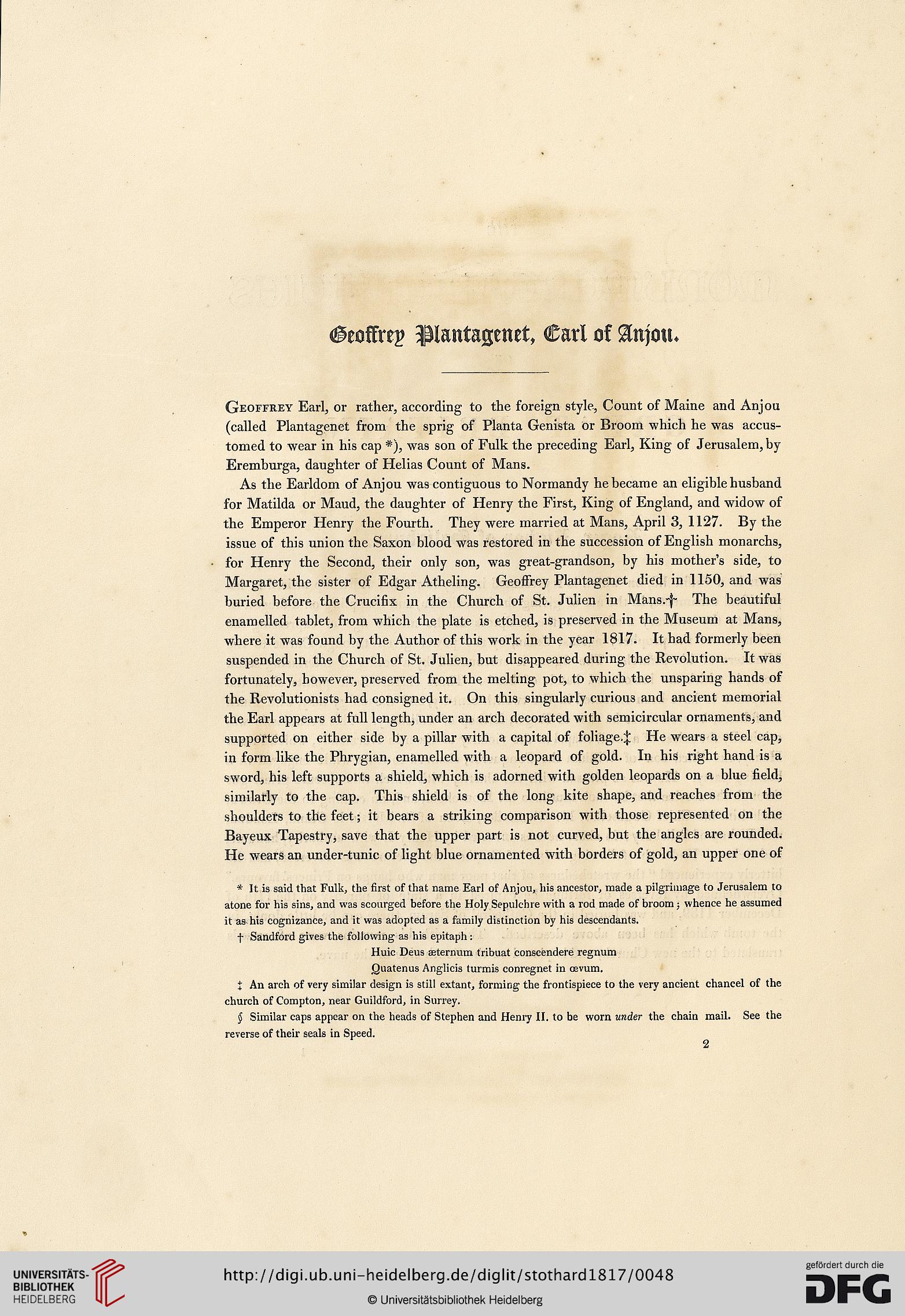plantagenet, €arl of !Jnjott.
GEOFFREY Earl, or rather, according to the foreign style, Count of Maine and Anjou
(called Plantagenet from the sprig of Planta Genista or Broom which he was accus-
tomed to wear in his cap =*), was son of Fulk the preceding Earl, King of Jerusalem, by
Eremburga, daughter of Helias Count of Mans.
As the Earldom of Anjou was contiguous to Normandy he became an eligible husband
for Matilda or Maud, the daughter of Henry the First, King of England, and widow of
the Emperor Henry the Fourth. They were married at Mans, April 3, 1127. By the
issue of this union the Saxon blood was restored in the succession of English monarchs,
for Henry the Second, their only son, was great-grandson, by his mother's side, to
Margaret, the sister of Edgar Atheling. Geodrey Plantagenet died in 1150, and was
buried before the Crucihx in the Church of St. Julien in Mans.^- The beautiful
enamelled tablet, from which the plate is etched, is preserved in the Museum at Mans,
where it was found by the Author of this work in the year 1817. It had formerly been
suspended in the Church of St. Julien, but disappeared during the Revolution. It was
fortunately, however, preserved from the melting pot, to which the unsparing hands of
the Revolutionists had consigned it. On this singularly curious and ancient memorial
the Earl appears at full length, under an arch decorated with semicircular ornaments, and
supported on either side by a pillar with a capital of foliage.^ He wears a steel cap,
in form like the Phrygian, enamelled with a leopard of gold. In his right hand is a
sword, his left supports a shield, which is adorned with golden leopards on a blue held,
similarly to the cap. This shield is of the long kite shape, and reaches from the
shoulders to the feet; it bears a striking comparison with those represented on the
Bayeux Tapestry, save that the upper part is not curved, but the angles are rounded.
He wears an under-tunic of light blue ornamented with borders of gold, an upper one of
* It is said that Fulk, the hrst of that name Earl of Anjou, his ancestor, made a pilgrimage to Jerusalem to
atone for his sins, and was scourged before the Holy Sepulchre with a rod made of broom; whence he assumed
it as his cognizance, and it was adopted as a family distinction by his descendants.
-f Sandford gives the following as his epitaph:
Huic Deus aeternum tribuat conscendere regnum
Quatenus Anglicis turmis conregnet in osvum.
t An arch of very similar design is still extant, forming the frontispiece to the very ancient chancel of the
church of Compton, near Guildford, in Surrey.
$ Similar caps appear on the heads of Stephen and Henry II. to be worn MMder the chain mail. See the
reverse of their seals in Speed.
2
GEOFFREY Earl, or rather, according to the foreign style, Count of Maine and Anjou
(called Plantagenet from the sprig of Planta Genista or Broom which he was accus-
tomed to wear in his cap =*), was son of Fulk the preceding Earl, King of Jerusalem, by
Eremburga, daughter of Helias Count of Mans.
As the Earldom of Anjou was contiguous to Normandy he became an eligible husband
for Matilda or Maud, the daughter of Henry the First, King of England, and widow of
the Emperor Henry the Fourth. They were married at Mans, April 3, 1127. By the
issue of this union the Saxon blood was restored in the succession of English monarchs,
for Henry the Second, their only son, was great-grandson, by his mother's side, to
Margaret, the sister of Edgar Atheling. Geodrey Plantagenet died in 1150, and was
buried before the Crucihx in the Church of St. Julien in Mans.^- The beautiful
enamelled tablet, from which the plate is etched, is preserved in the Museum at Mans,
where it was found by the Author of this work in the year 1817. It had formerly been
suspended in the Church of St. Julien, but disappeared during the Revolution. It was
fortunately, however, preserved from the melting pot, to which the unsparing hands of
the Revolutionists had consigned it. On this singularly curious and ancient memorial
the Earl appears at full length, under an arch decorated with semicircular ornaments, and
supported on either side by a pillar with a capital of foliage.^ He wears a steel cap,
in form like the Phrygian, enamelled with a leopard of gold. In his right hand is a
sword, his left supports a shield, which is adorned with golden leopards on a blue held,
similarly to the cap. This shield is of the long kite shape, and reaches from the
shoulders to the feet; it bears a striking comparison with those represented on the
Bayeux Tapestry, save that the upper part is not curved, but the angles are rounded.
He wears an under-tunic of light blue ornamented with borders of gold, an upper one of
* It is said that Fulk, the hrst of that name Earl of Anjou, his ancestor, made a pilgrimage to Jerusalem to
atone for his sins, and was scourged before the Holy Sepulchre with a rod made of broom; whence he assumed
it as his cognizance, and it was adopted as a family distinction by his descendants.
-f Sandford gives the following as his epitaph:
Huic Deus aeternum tribuat conscendere regnum
Quatenus Anglicis turmis conregnet in osvum.
t An arch of very similar design is still extant, forming the frontispiece to the very ancient chancel of the
church of Compton, near Guildford, in Surrey.
$ Similar caps appear on the heads of Stephen and Henry II. to be worn MMder the chain mail. See the
reverse of their seals in Speed.
2




